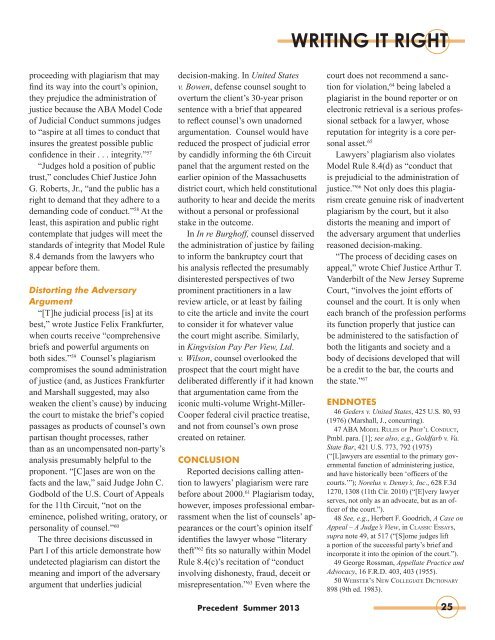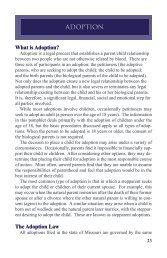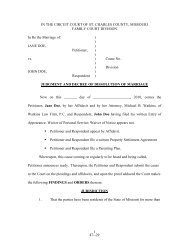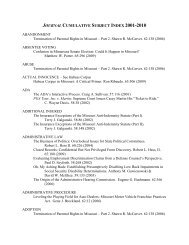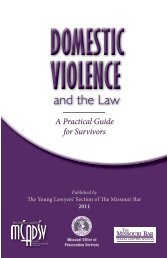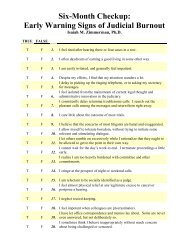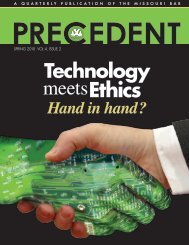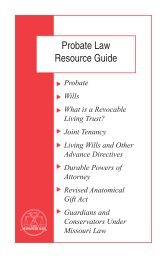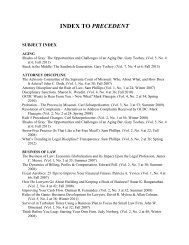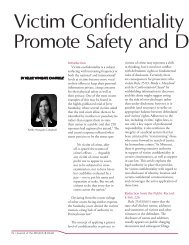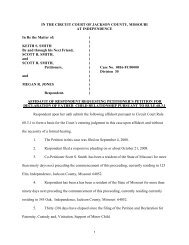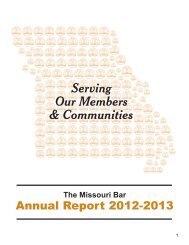Plagiarism in Lawyers' Written Advocacy (Part II) - the Missouri Bar
Plagiarism in Lawyers' Written Advocacy (Part II) - the Missouri Bar
Plagiarism in Lawyers' Written Advocacy (Part II) - the Missouri Bar
You also want an ePaper? Increase the reach of your titles
YUMPU automatically turns print PDFs into web optimized ePapers that Google loves.
WRITING IT RIGHTproceed<strong>in</strong>g with plagiarism that mayf<strong>in</strong>d its way <strong>in</strong>to <strong>the</strong> court’s op<strong>in</strong>ion,<strong>the</strong>y prejudice <strong>the</strong> adm<strong>in</strong>istration ofjustice because <strong>the</strong> ABA Model Codeof Judicial Conduct summons judgesto “aspire at all times to conduct that<strong>in</strong>sures <strong>the</strong> greatest possible publicconfidence <strong>in</strong> <strong>the</strong>ir . . . <strong>in</strong>tegrity.” 57“Judges hold a position of publictrust,” concludes Chief Justice JohnG. Roberts, Jr., “and <strong>the</strong> public has aright to demand that <strong>the</strong>y adhere to ademand<strong>in</strong>g code of conduct.” 58 At <strong>the</strong>least, this aspiration and public rightcontemplate that judges will meet <strong>the</strong>standards of <strong>in</strong>tegrity that Model Rule8.4 demands from <strong>the</strong> lawyers whoappear before <strong>the</strong>m.Distort<strong>in</strong>g <strong>the</strong> AdversaryArgument“[T]he judicial process [is] at itsbest,” wrote Justice Felix Frankfurter,when courts receive “comprehensivebriefs and powerful arguments onboth sides.” 59 Counsel’s plagiarismcompromises <strong>the</strong> sound adm<strong>in</strong>istrationof justice (and, as Justices Frankfurterand Marshall suggested, may alsoweaken <strong>the</strong> client’s cause) by <strong>in</strong>duc<strong>in</strong>g<strong>the</strong> court to mistake <strong>the</strong> brief’s copiedpassages as products of counsel’s ownpartisan thought processes, ra<strong>the</strong>rthan as an uncompensated non-party’sanalysis presumably helpful to <strong>the</strong>proponent. “[C]ases are won on <strong>the</strong>facts and <strong>the</strong> law,” said Judge John C.Godbold of <strong>the</strong> U.S. Court of Appealsfor <strong>the</strong> 11th Circuit, “not on <strong>the</strong>em<strong>in</strong>ence, polished writ<strong>in</strong>g, oratory, orpersonality of counsel.” 60The three decisions discussed <strong>in</strong><strong>Part</strong> I of this article demonstrate howundetected plagiarism can distort <strong>the</strong>mean<strong>in</strong>g and import of <strong>the</strong> adversaryargument that underlies judicialdecision-mak<strong>in</strong>g. In United Statesv. Bowen, defense counsel sought tooverturn <strong>the</strong> client’s 30-year prisonsentence with a brief that appearedto reflect counsel’s own unadornedargumentation. Counsel would havereduced <strong>the</strong> prospect of judicial errorby candidly <strong>in</strong>form<strong>in</strong>g <strong>the</strong> 6th Circuitpanel that <strong>the</strong> argument rested on <strong>the</strong>earlier op<strong>in</strong>ion of <strong>the</strong> Massachusettsdistrict court, which held constitutionalauthority to hear and decide <strong>the</strong> meritswithout a personal or professionalstake <strong>in</strong> <strong>the</strong> outcome.In In re Burghoff, counsel disserved<strong>the</strong> adm<strong>in</strong>istration of justice by fail<strong>in</strong>gto <strong>in</strong>form <strong>the</strong> bankruptcy court thathis analysis reflected <strong>the</strong> presumablydis<strong>in</strong>terested perspectives of twoprom<strong>in</strong>ent practitioners <strong>in</strong> a lawreview article, or at least by fail<strong>in</strong>gto cite <strong>the</strong> article and <strong>in</strong>vite <strong>the</strong> courtto consider it for whatever value<strong>the</strong> court might ascribe. Similarly,<strong>in</strong> K<strong>in</strong>gvision Pay Per View, Ltd.v. Wilson, counsel overlooked <strong>the</strong>prospect that <strong>the</strong> court might havedeliberated differently if it had knownthat argumentation came from <strong>the</strong>iconic multi-volume Wright-Miller-Cooper federal civil practice treatise,and not from counsel’s own prosecreated on reta<strong>in</strong>er.CONCLUSIONReported decisions call<strong>in</strong>g attentionto lawyers’ plagiarism were rarebefore about 2000. 61 <strong>Plagiarism</strong> today,however, imposes professional embarrassmentwhen <strong>the</strong> list of counsels’ appearancesor <strong>the</strong> court’s op<strong>in</strong>ion itselfidentifies <strong>the</strong> lawyer whose “literary<strong>the</strong>ft” 62 fits so naturally with<strong>in</strong> ModelRule 8.4(c)’s recitation of “conduct<strong>in</strong>volv<strong>in</strong>g dishonesty, fraud, deceit ormisrepresentation.” 63 Even where <strong>the</strong>Precedent Summer 2013court does not recommend a sanctionfor violation, 64 be<strong>in</strong>g labeled aplagiarist <strong>in</strong> <strong>the</strong> bound reporter or onelectronic retrieval is a serious professionalsetback for a lawyer, whosereputation for <strong>in</strong>tegrity is a core personalasset. 65Lawyers’ plagiarism also violatesModel Rule 8.4(d) as “conduct thatis prejudicial to <strong>the</strong> adm<strong>in</strong>istration ofjustice.” 66 Not only does this plagiarismcreate genu<strong>in</strong>e risk of <strong>in</strong>advertentplagiarism by <strong>the</strong> court, but it alsodistorts <strong>the</strong> mean<strong>in</strong>g and import of<strong>the</strong> adversary argument that underliesreasoned decision-mak<strong>in</strong>g.“The process of decid<strong>in</strong>g cases onappeal,” wrote Chief Justice Arthur T.Vanderbilt of <strong>the</strong> New Jersey SupremeCourt, “<strong>in</strong>volves <strong>the</strong> jo<strong>in</strong>t efforts ofcounsel and <strong>the</strong> court. It is only wheneach branch of <strong>the</strong> profession performsits function properly that justice canbe adm<strong>in</strong>istered to <strong>the</strong> satisfaction ofboth <strong>the</strong> litigants and society and abody of decisions developed that willbe a credit to <strong>the</strong> bar, <strong>the</strong> courts and<strong>the</strong> state.” 67ENDNOTES46 Geders v. United States, 425 U.S. 80, 93(1976) (Marshall, J., concurr<strong>in</strong>g).47 ABA Model Rules of Prof’l Conduct,Pmbl. para. [1]; see also, e.g., Goldfarb v. Va.State <strong>Bar</strong>, 421 U.S. 773, 792 (1975)(“[L]awyers are essential to <strong>the</strong> primary governmentalfunction of adm<strong>in</strong>ister<strong>in</strong>g justice,and have historically been ‘officers of <strong>the</strong>courts.’”); Norelus v. Denny’s, Inc., 628 F.3d1270, 1308 (11th Cir. 2010) (“[E]very lawyerserves, not only as an advocate, but as an officerof <strong>the</strong> court.”).48 See, e.g., Herbert F. Goodrich, A Case onAppeal – A Judge’s View, <strong>in</strong> Classic Essays,supra note 49, at 517 (“[S]ome judges lifta portion of <strong>the</strong> successful party’s brief and<strong>in</strong>corporate it <strong>in</strong>to <strong>the</strong> op<strong>in</strong>ion of <strong>the</strong> court.”).49 George Rossman, Appellate Practice and<strong>Advocacy</strong>, 16 F.R.D. 403, 403 (1955).50 Webster’s New Collegiate Dictionary898 (9th ed. 1983).25


